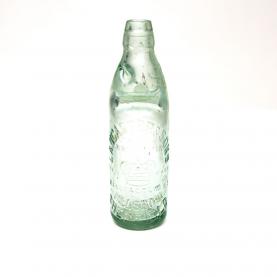Soft drinks
Soft drinks are produced by mixing three basic ingredients, namely syrup, water and carbon dioxide. The first soft drinks appeared in the 19th century, shortly after the process for manufacturing artificial sparkling mineral water was developed. In the 20th century, these sweet, fizzy, refreshing drinks offered an alternative to the increasingly high consumption of alcoholic beverages.
From mineral water in the 18th century to soft drinks
Soft drinks are sweet, fizzy, refreshing and alcohol-free. They consist of carbonated water with added syrup made from sugar and fruit or plant extracts.
The history of soft drinks is connected to the manufacturing of the first sparkling mineral water in the 18th century. Some mineral water springs were known for producing water which was rich in minerals and naturally carbonated. The sparkling aspect of this water, like seltzer water, had long been a mystery. In the 18th century, carbon dioxide was identified as the cause of these tiny bubbles. Production of the first artificially carbonated mineral water began a short while later.
In 1780, Johan Jakob Schweppe, a German inventor, developed an efficient process for carbonating water in Geneva. For a long time he had wanted to bottle spa water with all its benefits and make it available to everyone. As a result, he produced it artificially. The Schweppe, Paul and Gosse production plant opened in 1792 in London. The first bottles were egg-shaped, ‘to retain the gas more efficiently’, and therefore could not stand upright. The company started to produce soft drinks in the early 19th century.
In 1886 in the United States, an Atlanta pharmacist prepared a new syrup which, according to him, had soothing, thirst-quenching qualities. The syrup was initially diluted in chilled water, but became even more popular when mixed with carbonated water. This drink, Coca-Cola, was initially sold in pharmacies. The prohibition of alcohol in the United States, during the years which followed, encouraged the development of sweetened, flavoured carbonated water. Today, soft drinks dominate the non-alcoholic beverage market.
General method for manufacturing soft drinks
It is relatively simple to manufacture soft drinks by mixing three ingredients: water, syrup and carbon dioxide. Different types of sugar are used to make the syrup: sucrose, fructose (which is derived from starch), or sweeteners. A blend of plant or fruit extracts is added to this sugar solution, the composition of which remains a trade secret. The water and syrup are then mixed together in extremely precise proportions. The final stage in the process is the carbonation of the drink by adding carbon dioxide. Various acidifiers, sweeteners and colouring agents can be included in the industrial manufacturing of soft drinks. Energy drinks differ from soft drinks because of their very high caffeine content.
Nowadays, thanks to the soda machine, a home appliance which makes carbonating drinks easy, you can make your own soft drinks or mineral water.
The main virtue of soft drinks is that they are alcohol-free.
In 1904, in Toronto, a pharmacist and chemist who manufactured carbonated water thought of flavouring his product with ginger, thus inventing Canada Dry. In 1980, a famous advertising campaign presented the brand with the following slogan, against the backdrop of prohibition: ‘Canada Dry looks like alcohol, has the same golden colour of alcohol, but isn’t alcohol and that’s why it quenches your thirst’.
In 1907, the German soft drinks brand Bilz Brause changed its name and from then on was called Sinalco. A name which comes from the Latin sine alcohole which means without alcohol.
DE CAPITANI, François, 2005. Les eaux minérales en Suisse. In : L’eau à la bouche. Vevey Alimentarium. pp. 125-133.
GOUDOT, Sébastien, LAKHDARI, Omar, TAP, Julien, 2003. Etude d’une filière du secteur des boissons : Les Sodas. Projet de 2e année [en ligne]. Paris : Université Paris XII. Val de Marne. [Consulté le 22 décembre 2015]. Disponible à l’adresse : http://julientap.free.fr






